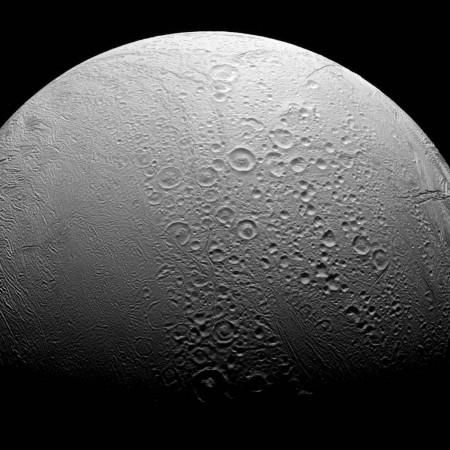
A latest image of Saturn's moon Enceladus has been released by NASA. The image was taken by Cassini spacecraft while it was analysing Saturn and its moons.
ALSO READ:
NASA's OSIRIS-REx spacecraft swings by Earth to get samples from asteroid Bennu: 7 things to know
Here's all you need to know about the stunning image:
1. The image portrays the crescent of Saturn's icy moon Enceladus which is lit up by the distant Sun and the rest of the moon can be seen dully illuminated by the gas-giant Saturn's reflection.
2. The image was captured by Cassini's narrow-angle camera on March 29, from a distance of 180,000 km (110,000 miles) from Enceladus.
3. The geysers of water ice and other materials being emitted to the cosmos from the south polar region of the moon can't be seen in this image.
4. The image scale is 1 kilometre (0.6 miles) per pixel. NASA officials revealed in an image description on Monday, September 25: "The sun-Enceladus-spacecraft (or phase) angle, at 141 degrees, is too low to make the moon's famous plumes easily visible."

5. The geysers of the icy moon Enceladus was detected by Cassini in 2005. With the data accumulated by the researchers, it was concluded that the source of the plume material of is the ocean of liquid water present in the subsurface of the moon.
6. Astronomers aimed at finding the molecular composition of the moon with the help of Near-Infrared Spectrograph (NIRSpec) and mid-infrared instrument (MIRI) along with its surface features.
7. The moon's ocean is speculated to have a potentially life-supporting energy source. The Cassini spacecraft's nearly 20-year-old mission ended on September 15, when it took a death plunge into the thick atmosphere of Saturn and burn. This suicidal dive was planned to prevent Saturn's moon potentially habitable moons Enceladus and Titan from getting contaminated by micro organisms from Earth because of Cassini.
The Cassini-Huygens was a $3.2 billion mission, it was a collaboration between NASA and ESA. It was launched in October 1997 and the craft reached around Saturn's orbit on June 30, 2004.

















